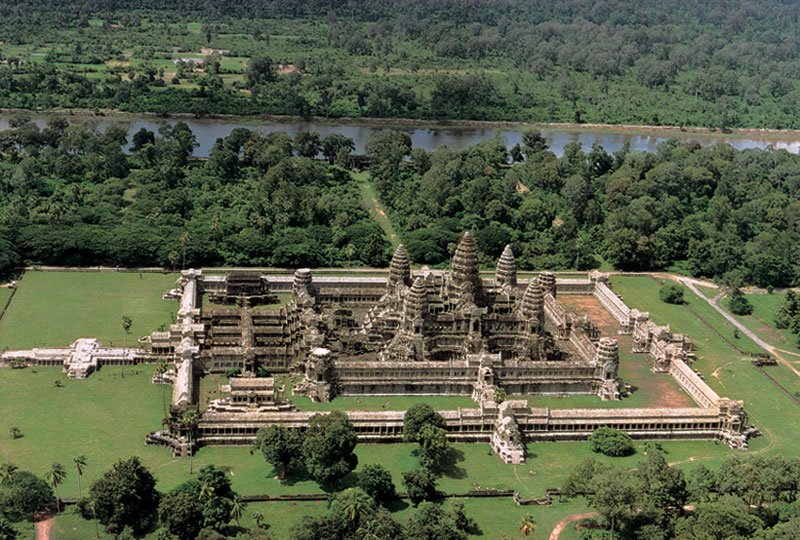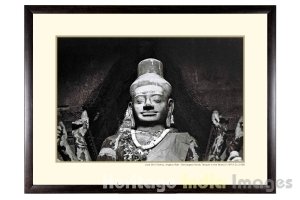 Angkor Wat - the largest Hindu Temple in the World and a World Heritage Site
Angkor Wat - the largest Hindu Temple in the World and a World Heritage Site
The word ‘Ankgor’ is derived from the Sanskrit word ‘nagar’, usually meaning the capital city or town. Since the capital of the Khmer Empire was generally located in the region, the ‘nagar’ word was used for it. However, sometime later, the pronunciation of the word changed from ‘nagar’ to nokor and ‘Angkor’. Today, the word ‘Angkor’ represents the glorious Khmer civilization that flourished in Kambuj between the 9th and the 14th centuries and also the whole site in Siem Reap province where the main temples built by this civilization are located. King Jayavarman II while founding the great Angkor civilisation in AD 802, first established his capital at Mahendra Parvatnow known as Phnom Kulen. Later he established his capital at Amrendrapur and Indrapur but finally settled at HariharÄlaya, the present site of Rolous group of temples. The capital was shifted toYashodharpur with Phnom Bakhaeng at its centre by King Yashovarman I during his reign in the end of the 9th cenury where it generally remained except for a short period when it was shifted to Kok Ker (Chok Gargyar) by King Jayavarman VI during his reign from A.D. 928 to 941.
Kambuj Desh
Kambuj Desh was the ancient name of Cambodia. Funan was the first state in this region, which absorbed and assimilated the Indian ideas in the early centuries of the Christian era. The Sanskrit language, script, traditions, customs, beliefs, religions, art, architecture, and legal and administrative systems from India were adopted with suitable adaptations. In the early 7th century, the state of Funan was conquered by its vassal state Kambuj known as Chenla in the Chinese chronicles. The first known dynasty of Kambuj came from King Shrutavarman followed by Bhavavarman who flourished in the middle of the 6th century. ĪshÄnvarman*, one of the renowned kings of this dynasty established his capital at Sambor Prei Kuk, an important Pre-Angkorian site. Jayavarman I was the last king of this family who supposedly ruled in the second half of the 7th century. The period following the death of King Jayavarman I is a dark period in the history of Kambuj. According to the Chinese chronicles, the country of Chenla was divided in to land Chenla and water Chenla in the 8th century. The obscurity prevailed thereafter. The history is traced again with the accession of Jayavarman II who founded the Angkor dynasty in AD 802 and consolidated Kambuj. Thereafter, Kambuj Desh evolved into a powerful state from the 9th century onwards and the Khmers became one of the highly evolved societies in the world. The creative genius and the innate devotional nature of the Khmers combined with the basic principles of Indian civilisation in the fields of religion, culture, art , architecture created the most beautiful temples in the world between the 9th and the 13th centuries including ‘Angkor Wat’ - the largest temple in the world and a rare creation of human civilisation.
Intangible cultural heritage" consists of non-physical aspects of a particular culture, more often maintained by social customs during a specific period in history. The concept includes the ways and means of behavior in a society, and the often formal rules for operating in a particular cultural climate. These include social values and traditions, customs and practices, aesthetic and spiritual beliefs, artistic expression, language and other aspects of human activity. The significance of physical artifacts can be interpretedagainst the backdrop of socioeconomic, political, ethnic, religious and philosophical values of a particular group of people. Naturally, intangible cultural heritage is more difficult to preserve than physical objects.
Indianisation
The contact of Southeast Asia with India started somewhere in the pre-historic times when the sea-trade relations between the two regions were established. Around the first century AD, many parts of Southeast Asia had started undergoing a process whereby Indian culture was assimilated by the local people. This process of cultural assihe contact of Southeast Asia with India started somewhere in the pre-historic times when the sea-trade relations between the two regions were established. Around the first century AD, many parts of Southeast Asia had started undergoing a process whereby Indian culture was assimilated by the local people. This process of cultural assimilation and development continued for centuries and through peaceful processes, the civilisation in the region continued to evolve further. Kambuj Desh, the most powerful and highly evolved in the region, comprised the whole of Cambodia and at different times, parts of Laos, Vietnam, Thailand and Myanmar of modern times as evident from the location of its ancient sites. The Khmers of ancient Kambuj now live in Cambodia, also known as Kampuchea which is the same word Kambuj but pronounced differently. In French, the name of the country is Cambodge, which is again derived from Kambuj. assimilation and development continued for centuries and through peaceful processes, the civilisation in the region continued to evolve further. Kambuj Desh, the most powerful and highly evolved in the region, comprised the whole of Cambodia and at different times, parts of Laos, Vietnam, Thailand and Myanmar of modern times as evident from the location of its ancient sites. The Khmers of ancient Kambuj now live in Cambodia, also known as Kampuchea which is the same word Kambujbutpronounced differently. In French, the name of the country is Cambodge, which is again derived from Kambuj.
 |
 |
 |